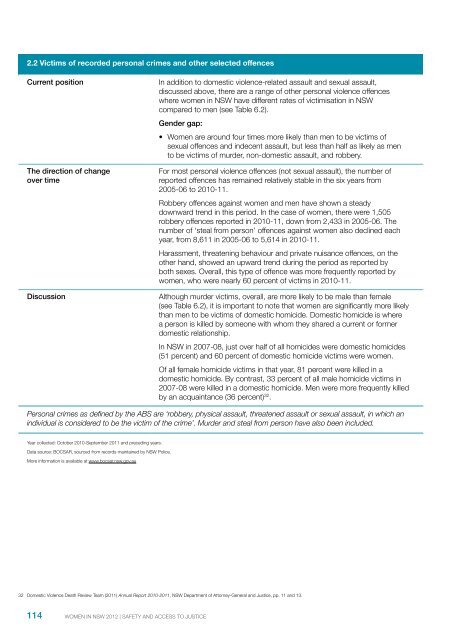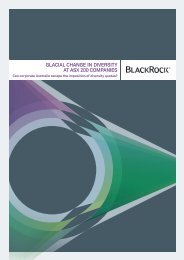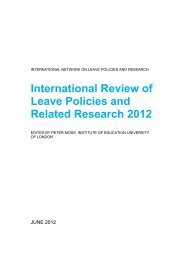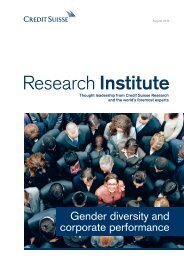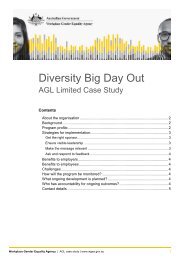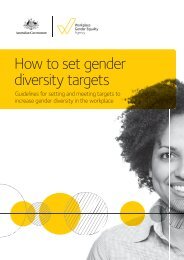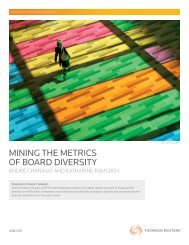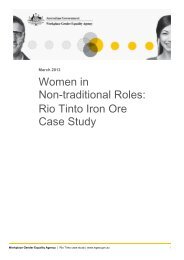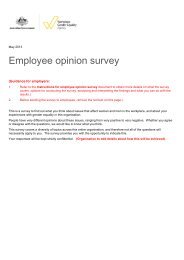Women in NSW 2012 - The Workplace Gender Equality Agency
Women in NSW 2012 - The Workplace Gender Equality Agency
Women in NSW 2012 - The Workplace Gender Equality Agency
You also want an ePaper? Increase the reach of your titles
YUMPU automatically turns print PDFs into web optimized ePapers that Google loves.
2.2 Victims of recorded personal crimes and other selected offencesCurrent position<strong>The</strong> direction of changeover timeDiscussionIn addition to domestic violence-related assault and sexual assault,discussed above, there are a range of other personal violence offenceswhere women <strong>in</strong> <strong>NSW</strong> have different rates of victimisation <strong>in</strong> <strong>NSW</strong>compared to men (see Table 6.2).<strong>Gender</strong> gap:• <strong>Women</strong> are around four times more likely than men to be victims ofsexual offences and <strong>in</strong>decent assault, but less than half as likely as mento be victims of murder, non-domestic assault, and robbery.For most personal violence offences (not sexual assault), the number ofreported offences has rema<strong>in</strong>ed relatively stable <strong>in</strong> the six years from2005-06 to 2010-11.Robbery offences aga<strong>in</strong>st women and men have shown a steadydownward trend <strong>in</strong> this period. In the case of women, there were 1,505robbery offences reported <strong>in</strong> 2010-11, down from 2,433 <strong>in</strong> 2005-06. <strong>The</strong>number of ‘steal from person’ offences aga<strong>in</strong>st women also decl<strong>in</strong>ed eachyear, from 8,611 <strong>in</strong> 2005-06 to 5,614 <strong>in</strong> 2010-11.Harassment, threaten<strong>in</strong>g behaviour and private nuisance offences, on theother hand, showed an upward trend dur<strong>in</strong>g the period as reported byboth sexes. Overall, this type of offence was more frequently reported bywomen, who were nearly 60 percent of victims <strong>in</strong> 2010-11.Although murder victims, overall, are more likely to be male than female(see Table 6.2), it is important to note that women are significantly more likelythan men to be victims of domestic homicide. Domestic homicide is wherea person is killed by someone with whom they shared a current or formerdomestic relationship.In <strong>NSW</strong> <strong>in</strong> 2007-08, just over half of all homicides were domestic homicides(51 percent) and 60 percent of domestic homicide victims were women.Of all female homicide victims <strong>in</strong> that year, 81 percent were killed <strong>in</strong> adomestic homicide. By contrast, 33 percent of all male homicide victims <strong>in</strong>2007-08 were killed <strong>in</strong> a domestic homicide. Men were more frequently killedby an acqua<strong>in</strong>tance (36 percent) 32 .Personal crimes as def<strong>in</strong>ed by the ABS are ‘robbery, physical assault, threatened assault or sexual assault, <strong>in</strong> which an<strong>in</strong>dividual is considered to be the victim of the crime’. Murder and steal from person have also been <strong>in</strong>cluded.Year collected: October 2010-September 2011 and preced<strong>in</strong>g years.Data source: BOCSAR, sourced from records ma<strong>in</strong>ta<strong>in</strong>ed by <strong>NSW</strong> Police.More <strong>in</strong>formation is available at www.bocsar.nsw.gov.au32 Domestic Violence Death Review Team (2011) Annual Report 2010-2011, <strong>NSW</strong> Department of Attorney-General and Justice, pp. 11 and 13.114 WOMEN IN <strong>NSW</strong> <strong>2012</strong> | SAFETY AND ACCESS TO JUSTICE


